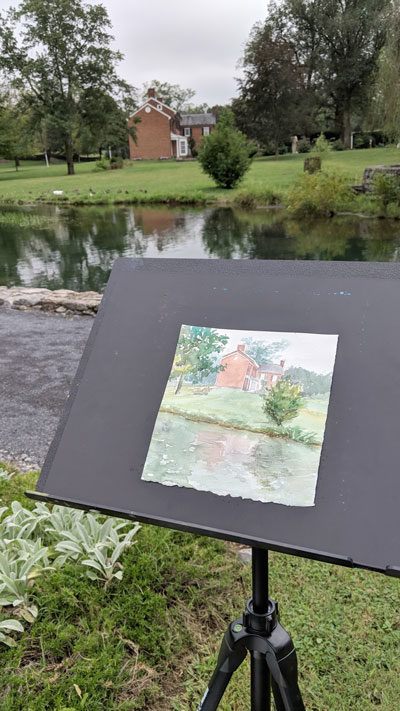
“Plein air” is a French term, loosely translated as “outdoor” and refers to the act of painting on location. The notoriety of plein air painting is most often attached to the development of French Impressionism in the 1870s as painters such as Claude Monet, Camille Pissarro, Edgar Degas, and Alfred Sisley eschewed the Classical conventions and dictates of the Académie des Beaux-Arts and the Salon de Paris and carried their easels outdoors where they attempted to convey their “impressions” of atmosphere and light.
However, as a watercolor artist, I look beyond the Impressionists to an even earlier time when English landscape artists such as J.R. Cozens, Thomas Girtin, John Constable, John Sell Cotman, and J.M.W. Turner seized the opportunities afforded by the 1767 invention of wove paper and the 1780 creation of watercolor “cakes.” With these innovations in hand, watercolorists sallied forth into the English countryside armed with painting kits and sable brushes. Well before Monet’s Haystack paintings, Constable was recording the appearance of the sky at various times of day in his watercolors.
I started painting “en plein air” in 2016. I had painted in watercolors for more than 25 years by that point, but as a mostly self-taught artist, I had relied on photographic references for my paintings. As a high school student, I vividly remember wandering out into the pasture behind our house with plans to paint the pretty view toward the meadow. I looked out onto that landscape and felt completely overwhelmed by the volume of visual information beyond the top edge of my paper. I made a feeble attempt to paint the scene, but it was terrible, so I kept working with photographs after that experience.
Fast forward to the summer of 2016, and the Museum of the Shenandoah Valley in Winchester, Va., was offering a one-day plein air workshop. I signed up for it because I wanted to see if I finally could conquer the fear I felt for plein air. It was a difficult workshop, but I ended the day feeling a boost of confidence.
On my own, I ventured back into the MSV gardens for another attempt, and even though my painting was dreadful, I had fun. So I started going to MSV during lunch breaks to paint. I was terribly self-conscious and nervous about my paintings, but MSV’s walled garden gave me a sense of safety and security. I bought a plein air easel and took a couple of workshops with experienced plein air painters. And in the years since that workshop, I have found that the more I paint plein air, the more I enjoy it and benefit from it.
Plein air is hard. Even very experienced painters will have a rough time of it in their first few plein air sessions (I wish I had understood that back in my high school years). There’s the weather to consider, the insects, the potential for sunburn/windburn, and curious onlookers. There is also the challenge of painting on a slanted easel (some watercolor artists, myself included, work on a mostly flat surface in a studio setting). And then there is a need to work a bit faster (the sun does not wait). All of these things are potentially uncomfortable and can throw an artist into a funk.
However, if the artist sticks with it, there are multiple benefits that can result. Painting plein air has improved my drawing skills immensely, and that has helped my studio work. I nowunderstand how the edges of a photograph can become a crutch for translating a scene on paper. Without that crutch, I’ve had to trust my eyes and practice skills where I visually measure and assess elements in relationship to one other. These are the basic skills that formally trained artists learn in ateliers and life-drawing sessions. Through plein air, the landscape has become my atelier.
As an added bonus, the pace of plein air work – again, the sun doesn’t wait for you — has benefited my studio paintings. I am not nearly as afraid of “messing up.” I feel bolder and quicker, and my paintings are fresher as a result. Finally, after years of painting, I now trust that the colorful splashes on my paper are the real star of the show, not the scene (or the reference photo).
Finally, there is something so refreshing about painting outside…. you can soak up the environment, listen to the birds, feel the breezes, etc. For me, it’s become a place to relieve stress and relax.
So I encourage you to give plein air a try. Start small, maybe just with a pencil and sketchbook. But stick with it, and it will make you a better artist.
